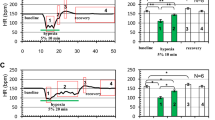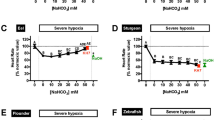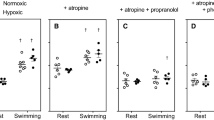Abstract
Adenosine is an endogenous nucleoside that acts via G-protein coupled receptors. In vertebrates, arterial or venous adenosine injection causes a rapid and large bradycardia through atrioventricular node block, a response mediated by adenosine receptors that inhibit adenylate cyclase and decrease cyclic AMP concentration. Chronic developmental hypoxia has been shown to alter cardioregulatory mechanisms in reptile embryos, but adenosine’s role in mediating these responses is not known. We incubated snapping turtle embryos under chronic normoxic (N21; 21 % O2) or chronic hypoxic conditions (H10; 10 % O2) beginning at 20 % of embryonic incubation. H10 embryos at 90 % of incubation were hypotensive relative to N21 embryos in both normoxic and hypoxic conditions. Hypoxia caused a hypotensive bradycardia in both N21 and H10 embryos during the initial 30 min of exposure; however, f H and P m both trended towards increasing during the subsequent 30 min, and H10 embryos were tachycardic relative to N21 embryos in hypoxia. Following serial ≥1 h exposure to normoxic and hypoxic conditions, a single injection of adenosine (1 mg kg−1) was given. N21 and H10 embryos responded to adenosine injection with a rapid and large hypotensive bradycardia in both normoxia and hypoxia. Gene expression for adenosine receptors were quantified in cardiac tissue, and Adora1 mRNA was the predominant receptor subtype with transcript levels 30–82-fold higher than Adora2A or Adora2B. At 70 % of incubation, H10 embryos had lower Adora1 and Adora2B expression compared to N21 embryos. Expression of Adora1 and Adora2B decreased in N21 embryos during development and did not differ from H10 embryos at 90 % of incubation. Similar to previous results in normoxia, H10 embryos in hypoxia were chronically tachycardic compared to N21 embryos before and after complete cholinergic and adrenergic blockade. Chronic hypoxia altered the development of normal cholinergic and adrenergic tone, as well as adenosine receptor mRNA levels. This study demonstrates that adenosine may be a major regulator of heart rate in developing snapping turtle embryos, and that chronic hypoxic incubation alters the response to hypoxic exposure.







Similar content being viewed by others
Abbreviations
- CAM:
-
Chorioallantoic membrane
- f H :
-
Heart rate (beats min−1), ‘frequency of heart beats’
- H10:
-
Turtle embryos artificially incubated in chronic hypoxia (10 % O2), beginning at 20 % of incubation/development
- N21:
-
Turtle embryos artificially incubated in chronic normoxia (21 % O2), beginning at 20 % of incubation/development
- P m :
-
Mean arterial pressure (kPa) measured through a CAM artery
- 70 %:
-
70 % of embryonic incubation/development for turtle embryos (~55 day total incubation)
- 90 %:
-
90 % of embryonic incubation/development for turtle embryos (~55 day total incubation)
References
Ackerman RA (1980) Physiological and ecological aspects of gas exchange by Sea Turtle eggs. Amer Zool 20:575–583
Alvine T, Rhen T, Crossley DA II (2013) Temperature-dependent sex determination modulates cardiovascular maturation in embryonic snapping turtles, Chelydra serpentina. J Exp Biol 216:751–758
Belardinelli L, West A, Crampton R, Berne RM (1983) Chronotropic and dromotropic effects of adenosine. In: Berne RM, Rall TW, Rubio R (eds) Regulatory function of adenosine. Martinus Nijhof Publishing, Boston, pp 377–398
Booth DT (1998) Nest temperature and respiratory gases during natural incubation in the broad-shelled river turtle, Chelodina expansa (Testudinata : Chaldea). Aus J Zool 46:183–191
Booth DT (2000) The effect of hypoxia on oxygen consumption of embryonic estuarine crocodiles (Crocodylus porosus). J Herp 34:478–481
Clemo HF, Belardinelli L (1986) Effect of adenosine on atrioventricular conduction: I. Modulation of atrioventricular node transmission by adenosine in hypoxic isolated guinea pig hearts. Circ Res 59:437–446
Corona TB, Warburton SJ (2000) Regional hypoxia elicits regional changes in chorioallantoic membrane vascular density in alligator but not chicken embryos. Comp Biochem Physiol A 125:57–61
Crawford NG, Faircloth BC, McCormack JE, Brumfield RT, Winker K, Glenn TC (2012) More than 1000 ultraconserved elements provide evidence that turtles are the sister group of archosaurs. Biol Lett 8:783–786
Crossley DA, Altimiras J (2000) Ontogeny of cholinergic and adrenergic cardiovascular regulation in the domestic chicken (Gallus gallus). Am J Physiol Reg Integ Comp 279:R1091–R1098
Crossley DA II, Altimiras J (2005) Cardiovascular development in embryos of the American Alligator Alligator mississippiensis: effects of chronic and acute hypoxia. J Exp Biol 208:31–39
Crossley DA II, Burggren WW (2009) Development of cardiac form and function in ectothermic sauropsids. J Morph 270:1400–1412
Crossley DA II, Burggren WW, Altimiras J (2003a) Cardiovascular regulation during hypoxia in embryos of the domestic chicken Gallus gallus. Am J Physiol Regul Integr Comp Physiol 284:219–226
Crossley DA II, Hicks JW, Altimiras J (2003b) Ontogeny of baroreflex control in the American Alligator Alligator mississippiensis. J Exp Biol 206:2895–2902
Dobson JG, Fenton RA, Romano FD (1987) The antiadrenergic actions of adenosine in the heart. In: Gerlach E, Becker BF (eds) Topics and perspectives in adenosine research. Springer, Berlin, pp 356–368
Dusseau JW, Hutchins PM, Malbasa DS (1986) Stimulation of angiogenesis by adenosine on the chick chorioallantoic membrane. Circ Res 59:163–170
Eme J, Altimiras J, Hicks JW, Crossley DA (2011a) Hypoxic alligator embryos: chronic hypoxia, catecholamine levels and autonomic responses of in ovo alligators. Comp Biochem Physiol A 160:412–420
Eme J, Crossley DA II, Hicks JW (2011b) Role of the left aortic arch and blood flows in embryonic American alligator (Alligator mississippiensis). J Comp Physiol B 181:391–401
Eme J, Hicks JW, Crossley DA II (2011c) Chronic hypoxic incubation blunts a cardiovascular reflex loop in embryonic American alligator (Alligator mississippiensis). J Comp Physiol B 181:981–990
Eme J, Rhen T, Tate KB, Gruchalla K, Kohl ZF, Slay CE, Crossley DA II (2013) Plasticity of cardiovascular function in snapping turtle embryos (Chelydra serpentina): chronic hypoxia alters autonomic regulation and gene expression. Am J Physiol Regul Integr Comp Physiol 304:R966–R979
Field DJ, Gauthier JA, King BL, Pisani D, Lyson TR, Peterson KJ (2014) Toward consilience in reptile phylogeny: miRNAs support an archosaur, not lepidosaur, affinity for turtles. Evol Dev. doi:10.1111/ede.12081
Fredholm BB, Dunwiddie TV (1988) How does adenosine inhibit transmitter release? Trends Pharmacol Sci 9:130–134
Fredholm BB, Arslan G, Halldner L, Kull B, Schulte G, Wasserman W (2000) Structure and function of adenosine receptors and their genes. N S Arch Pharmacol 362:364–374
Hylland P, Nilsson GE, Lutz PL (1994) Time course of anoxia-induced increase in cerebral blood flow rate in turtles: evidence for a role of adenosine. J Cerebral Blood Flow Metab 14:877–881
Joyce W, Gesser H, Wang T (2014a) Purinoceptors exert negative inotropic effects on the heart in all major groups of reptiles. Comp Biochem Physiol A 171:16–22
Joyce W, Gesser H, Wang T (2014b) Adenosinergic regulation of the cardiovascular system in the red-eared slider Trachemys scripta. Comp Biochem Physiol A 174:18–22
Koos BJ, Maeda T (2001) Adenosine A (2A) receptors mediate cardiovascular responses to hypoxia in fetal sheep. Am J Physiol Heart Circ Physiol 280:H83–H89
Miller NA (2008) PO2 in Loggerhead Sea Turtle (Caretta caretta) nests measured using fiber-optic oxygen sensors. Copeia 4:882–888
Miller SC, Gillis TE, Wright PA (2011) The ontogeny of regulatory control of the rainbow trout (Oncorhynchus mykiss) heart and how this is influenced by chronic hypoxia exposure. J Exp Biol 214:2065–2072
Mubagwa K, Mullane K, Flameng W (1996) Role of adenosine in the heart and circulation. Cardio Res 32:797–813
Piirainen H, Ashok Y, Nanekar RT, Jaakola VP (2011) Structural features of adenosine receptors: from crystal to function. Biochim Biophys Acta 1808:1233–1244
Ralevic V, Burnstock G (1998) Receptors for purines and pyrimidines. Pharmacol Rev 50:413–492
Ream M, Ray AM, Chandra R, Chikaraishi DM (2008) Early fetal hypoxia leads to growth restriction and myocardial thinning. Am J Physiol Regul Integr Comp Physiol 295:R583–R595
Rhen T, Metzger K, Schroeder A, Woodward R (2007) Expression of putative sex-determining genes during the thermosensitive period of gonad development in the snapping turtle, Chelydra serpentina. Sex Dev 1:255–270
Saura CA, Mallol J, Canela EI, Lluis C, Franco R (1998) Adenosine deaminase and A1 adenosine receptors internalize together following agonist-induced receptor desensitization. J Biol Chem 273:17610–17617
Schrader J (1990) Adenosine. A homeostatic metabolite in cardiac energy metabolism. Circulation 81:389–391
Soderstrom V, Nilsson GE, Renshaw GMC, Franklin CE (1999) Hypoxia stimulates cerebral blood flow in the estuarine crocodile (Crocodylus porosus). Neurosci Let 267:1–4
Stecyk JA, Stenslokken KO, Nilsson GE, Farrell AP (2007) Adenosine does not save the heart of anoxia-tolerant vertebrates during prolonged oxygen deprivation. Comp Biochem Physiol A 147:961–973
Tabrizchi R, Bedi S (2001) Pharmacology of adenosine receptors in the vasculature. Pharmacol Ther 91:133–147
Yntema CL (1968) A series of stages in the embryonic development of Chelydra serpentina. J Morph 125:219–256
Acknowledgments
The authors sincerely thank the State of Minnesota Department of Natural Resources for special permit No. 18337 to collect turtle eggs. Thanks to Kevin Tate and Kathryn Gruchalla for assistance. This work was supported by NSF CAREER award IBN IOS-0845741 to DAC and NSF award IBN IOS-0923300 to TR. No conflicts of interests, financial or otherwise, are declared by the authors.
Author information
Authors and Affiliations
Corresponding author
Additional information
Communicated by H.V. Carey.
Electronic supplementary material
Below is the link to the electronic supplementary material.
Supplementary Figs. S1–S7
S1 shows a neighbor-joining phylogenetic tree comparing amino acid sequences of C. serpentina to two turtles, alligator, chicken, green anole, Tasmanian devil, mouse and human. The scale bar on S1 indicates the number of amino acid changes per site (the number of changes divided by sequence length), and the blackened sequences represent the seven transmembrane domains. S2 and S3 show amino acid and nucleotide alignments for Adora1 receptor, respectively, S4 and S5 show amino acid and nucleotide alignments for Adora2A receptor, respectively, and S6 and S7 show amino acid and nucleotide alignments for Adora2B receptor, respectively (PDF 1,174 kb)
Rights and permissions
About this article
Cite this article
Eme, J., Rhen, T. & Crossley, D.A. Adjustments in cholinergic, adrenergic and purinergic control of cardiovascular function in snapping turtle embryos (Chelydra serpentina) incubated in chronic hypoxia. J Comp Physiol B 184, 891–902 (2014). https://doi.org/10.1007/s00360-014-0848-6
Received:
Revised:
Accepted:
Published:
Issue Date:
DOI: https://doi.org/10.1007/s00360-014-0848-6




